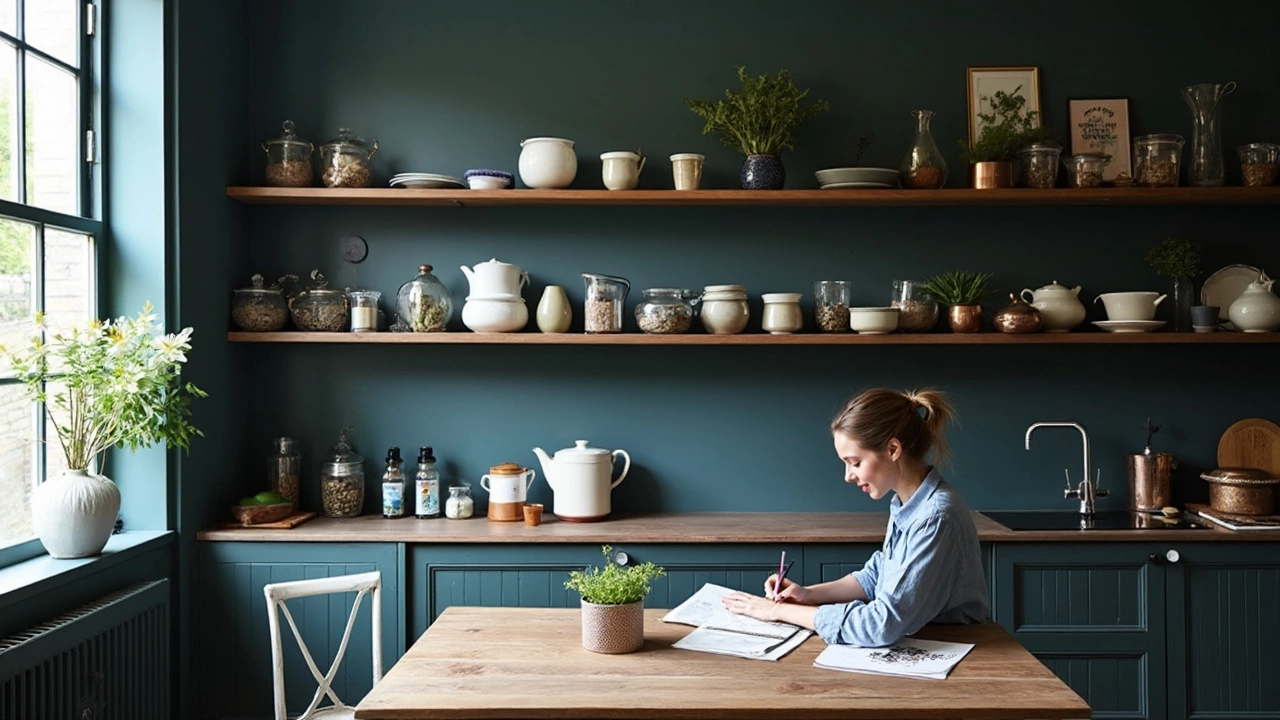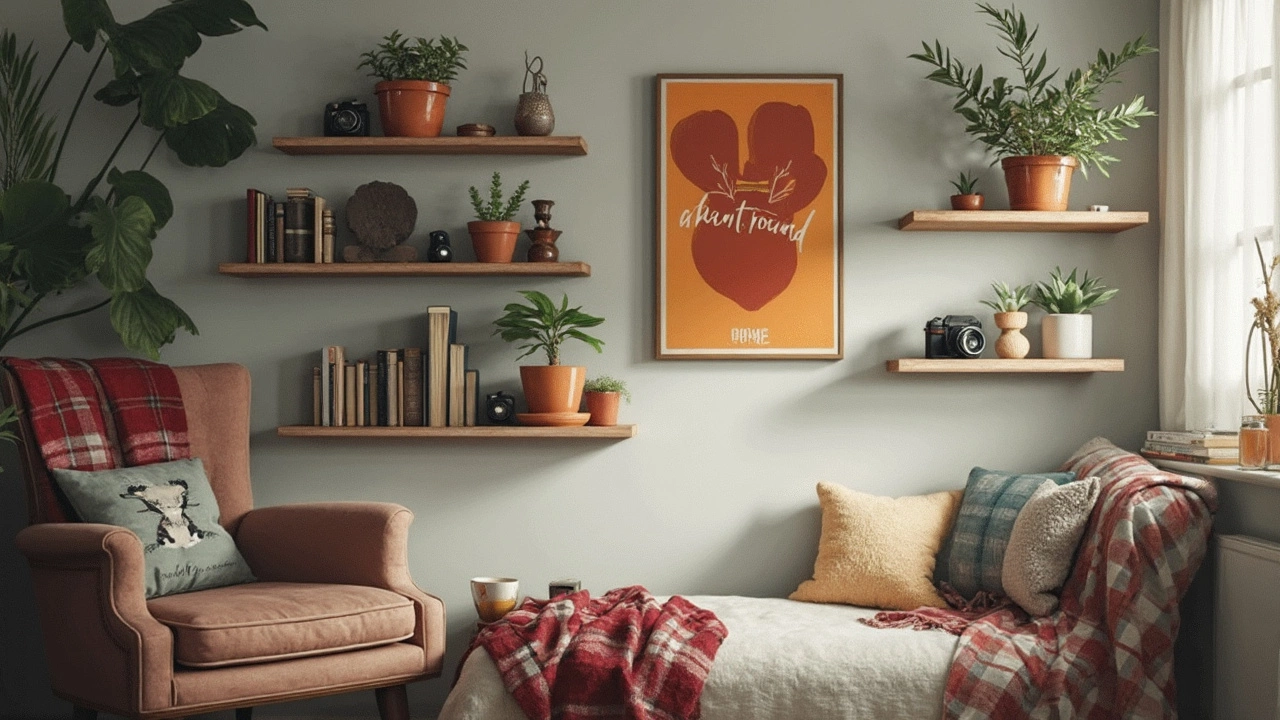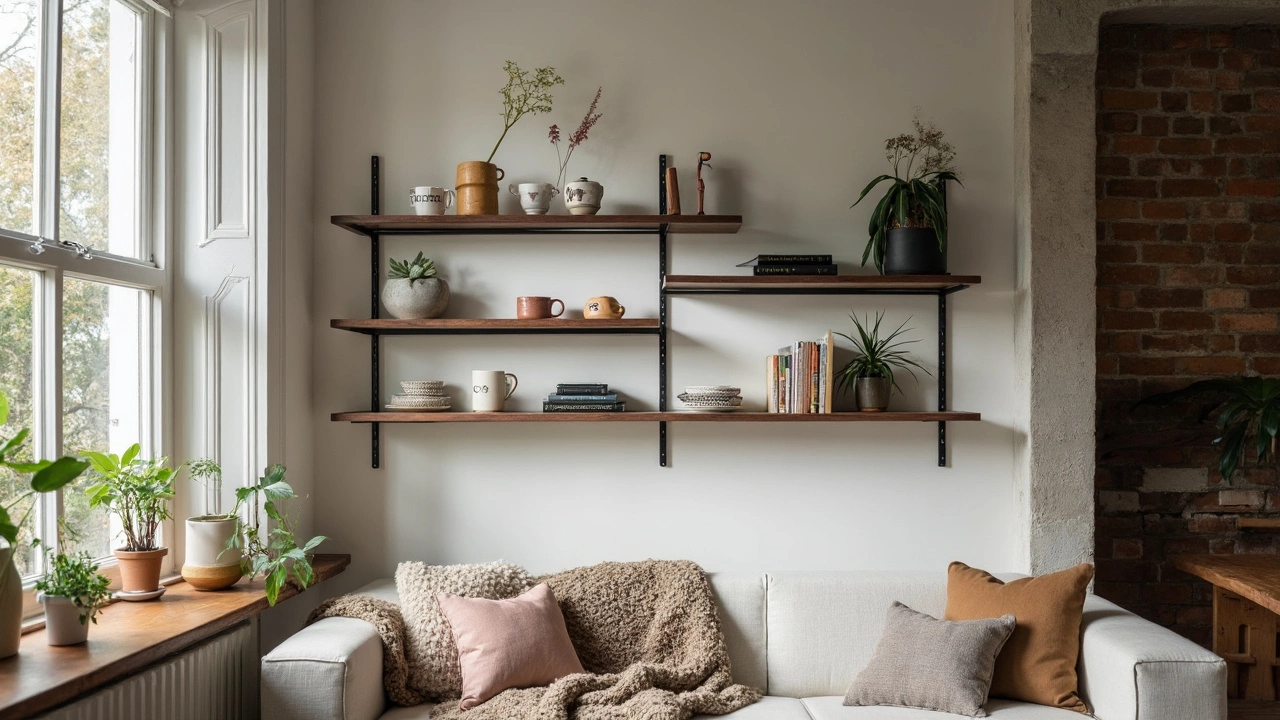You walk into a friend’s place and spot those sleek floating shelves above the sofa. Suddenly, you wonder—are these things still cool, or are they just a holdover from Pinterest circa 2015? People are asking this a lot lately, especially as home styles change so quickly.
Here's the real story: floating shelves aren’t “out” just because they’ve been everywhere. What matters is how you use them. Designers keep tweaking these shelves—changing up materials, shapes, and how they’re styled—so they’re far from feeling stale. If you love streamlined storage with zero bulky brackets, floating shelves are still a solid move.
Thinking about adding a few to your own wall (or maybe ripping down the old ones)? It comes down to a few basics. First, look at the vibe you want for your room. Floating shelves can look super modern, totally farmhouse, or even bold and artsy, depending on what you put on them and what they’re made of.
- Floating Shelves—Still in Style?
- Pros and Cons: What You Need to Know
- How Designers Use Floating Shelves in 2025
- Fresh Ways to Style Your Shelves
- Common Mistakes (and How to Dodge Them)
- Picking the Best Floating Shelves for Your Home
Floating Shelves—Still in Style?
It’s easy to think floating shelves are old news, but the numbers say otherwise. A quick look at Google Trends for 2024 shows searches for “floating shelves” are actually holding steady, with a steady bump around spring and fall—prime home-decor season. Over on Instagram, there are well over 500,000 posts tagged with #floatingshelves, and the hashtag keeps trending up every year.
Why does this simple shelf last? For starters, floating shelves just make sense for people wanting a clean, flexible way to show off stuff or stash things. Without chunky brackets, your wall looks less cluttered. And compared to big bookcases, they’re a breeze to clean around and swap out.
Some design insiders, like those at Houzz and Apartment Therapy, have noticed a shift in how people use these shelves. You’ll see them now with natural wood, bold colors, and even metal finishes. No more cookie-cutter “all white, all the time.” There’s also more talk about mixing up heights or lengths to create a custom look.
Just how common are these shelves these days? Here’s a quick peek:
| Year | Google Search Volume (per month) | #floatingshelves Instagram Posts |
|---|---|---|
| 2020 | 22,000 | 310,000 |
| 2022 | 24,500 | 400,000 |
| 2024 | 25,000 | 510,000 |
So, are floating shelves dated? If anything, they’re getting a second wind. Home influencers, small-space renters, and families needing quick storage are all still into them—they’re just finding fresh ways to make them work.
Pros and Cons: What You Need to Know
Floating shelves look sharp, but are they always the best pick? Here’s a real breakdown—no sugarcoating—of what’s great and what’s not so great about these shelves.
- Floating shelves create a super clean, modern look because you don’t see any brackets or hardware. They work well if you want your stuff to be the focus, not the shelf itself.
- They open up small rooms. Ditching clunky furniture or bulky cabinets means walls feel lighter and less crowded.
- Custom options are everywhere. You’ll find floating shelves made of wood, glass, metal, or even acrylic, which means you can match almost any style or budget.
But nothing’s perfect:
- They don’t hold as much weight as regular wall shelves with visible brackets. You can’t stack tons of heavy books or big kitchen appliances on them. The general max is usually about 30-50 lbs per shelf (with good anchors and studs). Cheap drywall anchors? Don’t risk it.
- They show off dust (and clutter) like nobody’s business. If you’re not into regular wiping or thoughtful displays, they can get messy fast.
- Installation matters. You have to find the wall studs, line things up perfectly, and use proper anchors. A quick shortcut can mean a wobbly shelf—or even worse, a pile of broken dishes.
Wondering how they really compare? Here’s a quick look at some numbers that might help you decide:
| Feature | Floating Shelves | Traditional Shelves |
|---|---|---|
| Visible Hardware | No | Yes |
| Weight Capacity* | 30-50 lbs | Up to 100 lbs |
| Installation Skill | Medium/High | Low/Medium |
| Custom Style Options | Wide variety | Wide variety |
| Room Opening/Lightness | High | Medium |
*Actual weight limits depend on your wall material, anchors, and shelf size. Always follow the manufacturer’s guide.
If you’re looking for something with serious storage, or you want a really easy install, you might lean traditional. But if you like a clean look and don’t need to stash a hundred pounds on one plank, floating shelves can be a win.

How Designers Use Floating Shelves in 2025
Designers are not letting floating shelves gather dust. In 2025, they’re more creative than ever with how and where they use them. Instead of just lining them up above kitchen counters, designers pop floating shelves in entryways, bathrooms, and even bedrooms. The main trick? Using shelves to solve real storage problems, not just for pretty displays.
For kitchens, there’s a strong move toward mixing materials. You’ll see natural wood against tile backsplashes, metal shelves for an industrial vibe, and glass shelves to keep things feeling light. In small bathrooms, designers mount floating shelves over toilets or next to vanities to store essentials and keep counters clear.
Living rooms are all about layering and flexibility. Instead of one long shelf, designers stack two or three short ones with different depths for more interest. Here’s a quick look at where and how designers use floating shelves most in 2025:
- Kitchen: Breakfast nooks, coffee stations, and even above stove areas (using heat-resistant materials)
- Bathroom: Over towel racks, above the toilet, or beside the mirror for skincare products
- Living Room: Media walls, reading corners, and around fireplaces
- Entryway: Drop zones for keys, mail, sunglasses, and small planters
- Bedrooms: Above headboards, as nightstand alternatives, or for book displays
The other thing designers get right? Avoiding clutter. Instead of cramming every shelf full, they go for simple groupings—think three vases in varying sizes, or a couple of framed photos balanced with a stack of books. There’s a 2024 survey from the National Kitchen & Bath Association showing that 78% of designers used floating shelves in at least one project last year, mostly for kitchens and bathrooms.
| Room | Popular Material in 2025 | Top Use |
|---|---|---|
| Kitchen | Natural wood, powder-coated steel | Open dishware, coffee stations |
| Bathroom | Tempered glass, floating veneer | Towels, toiletries |
| Living Room | Mixed wood and metal, laminate | Decor displays, books |
| Entryway | Oak, birch plywood | Drop zone, decor |
Remember, the most important thing with floating shelves is to make them fit the purpose of your room. Designers in 2025 focus on usefulness just as much as looks, and that’s why these shelves aren’t going anywhere soon.
Fresh Ways to Style Your Shelves
If you think floating shelves only work with a few framed photos and a potted plant, buckle up. There’s way more you can do, and a few simple switches keep them looking slick and up to date—especially if you want your shelves to feel custom, not copy-paste.
A good rule today? Mix up shapes, heights, and colors instead of forcing everything to match. Designers in 2025 use floating shelves for all kinds of setups: minimalist kitchens with a row of simple ceramics, bathrooms with rolled towels, or living rooms where art leans instead of hangs. No more formulaic book-over-vase drills.
- Floating shelves pop when you mix materials—think wood against painted walls, or matte black metal on patterned wallpaper. This makes shelves stand out instead of blending in.
- If you’re into plants, skip the tiny succulents and go big, with trailing pothos or dramatic snake plants. Just remember, they need sunlight, so don’t block them behind heavy decor.
- Larger items like stacked books, baskets, or bold art prints work better than a bunch of little knickknacks. Group a few items for each shelf, then leave some space empty on purpose. It keeps things from looking crowded.
- Consider the rest of the room. Use shelf colors and objects that echo your rugs, sofas, or cabinet handles for a pulled-together effect.
If you like to change things up, swap out shelf displays by season or even by month. People are doing this more often now—updating a couple of pieces for summer, a tiny pumpkin in fall, or a string of holiday lights in winter.
If you want a quick style breakdown, check this table for trends designers are actually using in 2025:
| Style Idea | What It Looks Like |
|---|---|
| Layered Art | Multiple framed prints, leaning and overlapping |
| Mixed Materials | Combining wood, metal, and glass on one set of shelves |
| Statement Shelf | One oversized item (like a bold sculpture or lamp) per shelf |
| Color Stories | Grouping objects by color for a curated vibe |
| Minimal Groupings | 3-5 objects max per shelf, with open space |
Try snapping a photo before and after rearranging—sometimes what looks good in person feels totally different on camera. If you’re stuck, scroll Instagram or look up "#floatingshelves" for real-life setups people love right now. That way, you get ideas that actually work in spaces people live in—not just staged showrooms.

Common Mistakes (and How to Dodge Them)
People love floating shelves—until they put them up and something just feels… off. If you want your shelves to look great and actually work as storage, you need to skip the most common trip-ups. No shame—we’ve all seen a shelf slowly sagging or watched everything come tumbling down because the wall anchors weren’t strong enough.
Here’s what messes with most setups and, better yet, how you can dodge the drama:
- Floating shelves installed without hitting wall studs. Shelves just screwed into drywall? That’s DIY heartbreak waiting to happen. Always use a stud finder, or pick the best drywall anchors you can get (look for heavy-duty ones rated for 50 lbs or more per anchor).
- Shelves spaced way too close—or way too far apart. Squished shelves limit what you can display, while awkward gaps make your wall look unfinished. Standard practice: allow at least 12-16 inches between them for most items.
- Overloading with heavy stuff. This is a classic. One survey by Houzz in 2023 found 38% of floating shelf fails stemmed from people loading up their shelves with books, appliances, or massive plants. Stick to lighter objects unless your shelves are commercial grade.
- Poor leveling. Crooked shelves make even the coolest setup look sloppy. Always use a level—old-school bubble or the one on your phone. It takes two extra minutes and saves you endless frustration later.
- Choosing the wrong depth and width. Super shallow shelves barely hold anything, while super deep ones can look clunky and droop. Typical kitchen floating shelves range from 8 to 12 inches deep, which works for most uses.
Let’s get even more real—check out how the biggest floating shelving fails stack up, stat-wise:
| Mistake | Percent of Reported Issues |
|---|---|
| Improper anchoring | 42% |
| Overloading shelves | 38% |
| Poor leveling | 12% |
| Bad spacing/layout | 8% |
How do you skip the headache? Go slow: measure twice, drill once. Double-check your shelf specs—especially load limits. Whenever possible, anchor at least one side into a stud, and always use that level. It’s kind of amazing what a little careful prep can prevent.

